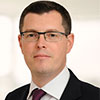Global assets in passive funds have surged over the past 15 years. According to a report released last October by PwC, they are on track to jump from $14.2 trillion in 2016 when they comprised 17 per cent of assets under management, to $36.6 trillion by 2025, accounting for about a quarter of AuM. (1)
Maybe that’s not surprising. Every basis point an investor doesn’t spend on portfolio management fees goes straight to the bottom line. Some active fund managers can successfully add value, particularly in markets that are less efficiently priced, but not all have been as successful at convincing investors of the benefits of their approach.
Chart 1 Source: EPFR (January 2018)
Charts 2 and 3 Source: Morningstar as at 27 February 2018, Worldwide OE, MM & ETF ex FoF ex Feeder. Broadridge European Market Review 2017
For investors, it can be difficult to justify an investment which they think has a reasonably small percentage chance of outperforming an index by one or two percent, for which they must pay what seems like a relatively high fee.
A common industry response is that investors simply have to pick a good active manager rather than an average one. In practice, identifying funds that will consistently outperform over time or over the cycle is not all that straightforward. Still, while it can be difficult to outperform in liquid, efficient markets, such as US large-caps, there is potentially more opportunity for clients to earn positive alpha in more illiquid or less well-researched markets. Active managers have not always been good at showing investors this potential to add value, so passive has been a cost-based choice for many.
The cost factor cannot be overstated in explaining the rise of passive. When returns from markets are generally high, marginal alpha matters less to investors. When returns from beta are low, people care much more.
The rise of exchange-traded funds (ETFs) and exchange-traded products (ETPs) linked to indices also facilitated the rise of passive, due not only to their low fees but to their flexibility and intra-day trading, as well as their simplicity and convenience for investors. Earlier this year, total global assets in ETFs and ETPs surpassed a milestone of $5 trillion for the first time, according to research firm ETFGI. (2)
Global regulatory trends also help explain the popularity of passive, with a greater emphasis on costs and transparency. This includes European conduct rules such as MiFID II aimed at enhancing consumer protection, as well as increased scrutiny from regulatory bodies like the European Securities and Markets Authority (ESMA), which has undertaken a large-scale assessment of the reporting of costs and past performance of retail investment products. This trend will continue to drive growth of index-tracking funds.
There has also been a proliferation of ETF products offering increasingly granular or specific exposures across a range of asset classes. This has provided investors with a diverse set of building blocks which allow them to implement their specific views in a very efficient, cost-effective way. This development has led to a redefinition of alpha and a blurring of the line between active and passive as investors are using passive exposures to implement active views. Combining active and passive products and using ETFs to fine-tune allocations allows clients to manage costs and free up budget for asset classes where cheaper passive or smart beta options are not available (for example, in real estate) and where they are willing to pay more for alpha in the pursuit of higher returns.
Meanwhile, retail investors used to trading stocks have embraced the simplicity and convenience of ETFs products, particularly in the US, where this has contributed to the transformation of the market into a mainstream one. They trade like stocks, and allow investors to trade the entire market as if it were a single stock - all while active broad-market funds have been struggling to outperform the index. Generally, retail usage is less tactical in nature and their rationale is one of easy, low-cost access to market growth, but the outcome is much the same - more inflows into ETFs and mounting downward pressure on fees for the industry as a whole.
Active managers have responded to this changing landscape by offering different fee structures, including variable management fees. Significantly, Japan’s Government Pension Investment Fund (GPIF), the world’s largest pension fund with $1.5 trillion in assets under management, recently decided it will pay fees to its active managers according to their multiyear performance. Investment returns will be evaluated over three to five years, in order to avoid concentrating only on short-term results, with progressively higher fees paid for outperformance and lower fees for consistently missing targets.
Current market conditions could help active managers make their case for improved returns. In markets with high correlation between stocks and low dispersion of returns, it can be difficult to generate alpha. Where dispersion of returns is higher, there should be more opportunity for alpha generation. A strong bull market tends to make it easy to overlook alpha, as returns from beta are so high.
The key point for investors is to determine where they want to just use low-cost passive products, and where they want to pay more for the potential for outperformance. The question is not whether to choose active or passive overall, but how to combine the two, and where it makes sense to pay more for added value.






































